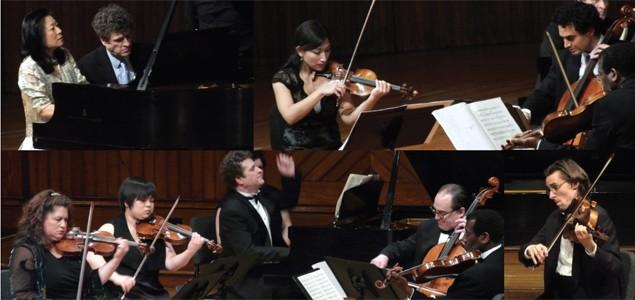Season begins with Bach and Mendelssohn
The Boston Chamber Music Society celebrated the beginning of its 32nd season with Sunday’s unforgettable performance of music by Johann Sebastian Bach and Felix Mendelssohn. The program for Sept. 28th featured Marcus Thompson, the artistic director of the society, playing viola, Jennifer Frautschi on violin, Raman Ramakrishnan on cello and Randall Hodgkinson on piano. The best seats in Harvard’s Sanders Theatre sold out quickly, and the packed venue charmed the audience with its Gothic architecture and wooden detailing, as well as its outstanding acoustics.
At the beginning of the concert, Thompson came on stage to announce a change in the coming season. The Boston Chamber Music Society will be alternating venues between the Sanders Theatre and the Fitzgerald Theatre at Cambridge Rindge and Latin School, concluding the season in May back at Sanders Theatre. He also announced some of the main features, including a performance dedicated to Mozart, French composers and the famous “Piano Trio in A minor” by Tchaikovsky.
Once these announcements were made, the lights dimmed and the performers came on stage. They began the concert with Bach’s infamous “Goldberg Variations,” which provided a textbook example of “variation,” in which melodies are repeated in various forms. Bach’s baroque style was very evident in the delivery of this ornate piece. Though it was originally composed for the harpsichord, in this performance, the piano acted as a substitute, adding an interesting new aspect to the piece. Each of the instruments had a chance to be in the spotlight. The 30 variations included parts of the piece played by two, three and sometimes, all four instruments playing together.
The variations began with the Aria, featuring only the string instruments. The slow, delicate pace and overlap of instruments was truly a breathtaking experience. I couldn’t help but imagine the quartet daintily performing this piece at a ball in “Pride and Prejudice.” The first variation introduced a lively melody with all four instruments and continued the procession of the following variations for an hour. The audience was completely engrossed throughout all 30 variations.
Given the baroque characteristics of formality and reserved performance technique, the artists were able to keep the crowd’s attention by conveying their emotion through dramatic fluctuation in volume. The artists even reflected this change in volume through their mannerisms: The pianist crouched closely to the keys to emphasize the softness of some parts and dramatically whipped his hands off the keys to show the intensity of others.
The Goldberg Variations in particular showcased the piano and its embellished melodies. The pianist, Randall Hodgkinson, showcased his tactical prowess by maintaining an incredible speed with complete accuracy. He knew precisely when to emphasize a section by becoming extremely quiet and how to contrast it with a controlled influx in volume. The violist Marcus Thompson and cellist Raman Ramakrishnan also created beautiful, overlapping harmonies while balancing their deep sounds with the soaring tones of Jennifer Frautschi’s violin. The members of this quartet gracefully expressed their impeccable ability to communicate with one another without even the slightest falter. Deservedly, the quartet received a standing ovation and an abundance of bravos.
The next piece, performed by Frautschi on violin, Hodgkinson on piano and Ramakrishnan on cello, was a great contrast to the previous work. The trio started off with Ramakrishnan’s cello resonating a deep, passionate melody, accompanied by Hodgkinson’s quiet, rumbling piano in the background. Then Frautschi made her dramatic introduction by following the aching melody of the cello. This movement gave Ramakrishnan the spotlight; the quick pace of the first movement with all three instruments provided a great contrast to his slow-paced, emotion-filled melodies. Unlike the charming Goldberg Variations, this piece evoked a sense of sorrowful yearning throughout the first movement.
The piece then transitioned into the second movement, which displayed the trio’s dynamic techniques and varying ranges of emotion and presentation. Between the movements, I could hear the “oohs” and “aahs” of the audience caught in the moment of fervor. The passion heard in the first movement and the patience of the second juxtaposed the quick, effervescent delivery of the third in which all the key elements of the piece came together in a fiery crescendo.
The Piano Trio ended literally with a boom; all the musicians slammed their bows and fingers on their instruments, physically demonstrating the victory of completing such an arduous piece. Naturally, the audience reflected that passion by immediately rising from their seats and once again holding a standing ovation long enough for the performers to come back onstage three times.
Each of the members contributed toward an unforgettable night of music by Bach and Mendelssohn. Normally, I would limit myself to clapping, but that night’s performance unequivocally deserved my emphatic bravos.




